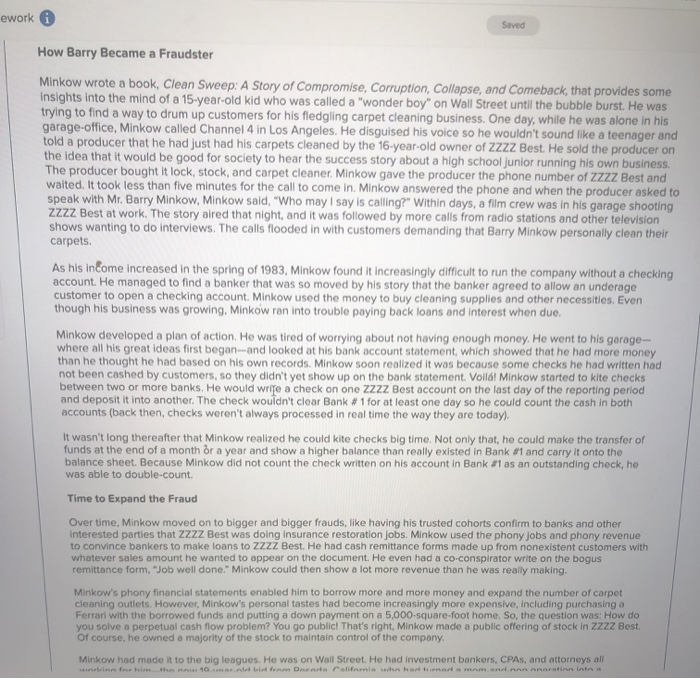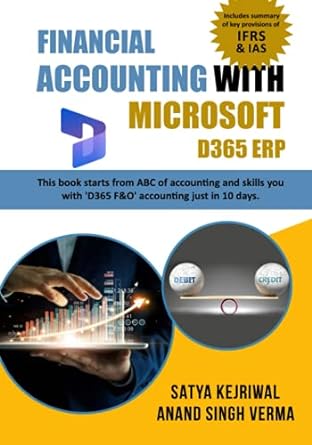ework Saved How Barry Became a Fraudster Minkow wrote a book, Clean Sweep: A Story of Compromise, Corruption, Collapse, and Comeback, that provides some Insights into the mind of a 15-year-old kid who was called a "wonder boy" on Wall Street until the bubble burst. He was trying to find a way to drum up customers for his fledgling carpet cleaning business. One day, while he was alone in his garage-office, Minkow called Channel 4 in Los Angeles. He disguised his voice so he wouldn't sound like a teenager and told a producer that he had just had his carpets cleaned by the 16-year-old owner of ZZZZ Best. He sold the producer on the idea that it would be good for society to hear the success story about a high school junior running his own business. The producer bought it lock, stock, and carpet cleaner. Minkow gave the producer the phone number of ZZZZ Best and waited. It took less than five minutes for the call to come in. Minkow answered the phone and when the producer asked to speak with Mr. Barry Minkow, Minkow said, "Who may I say is calling?" Within days, a film crew was in his garage shooting ZZZZ Best at work. The story aired that night, and it was followed by more calls from radio stations and other television shows wanting to do interviews. The calls flooded in with customers demanding that Barry Minkow personally clean their carpets. As his income increased in the spring of 1983, Minkow found it increasingly difficult to run the company without a checking account. He managed to find a banker that was so moved by his story that the banker agreed to allow an underage customer to open a checking account. Minkow used the money to buy cleaning supplies and other necessities. Even though his business was growing, Minkow ran into trouble paying back loans and interest when due. Minkow developed a plan of action. He was tired of worrying about not having enough money. He went to his garage- where all his great ideas first began-and looked at his bank account statement, which showed that he had more money than he thought he had based on his own records. Minkow soon realized it was because some checks he had written had not been cashed by customers, so they didn't yet show up on the bank statement. Voil! Minkow started to kite checks between two or more banks. He would wire a check on one zzzz Best account on the last day of the reporting period and deposit it into another. The check wouldn't clear Bank #1 for at least one day so he could count the cash in both accounts (back then, checks weren't always processed in real time the way they are today). It wasn't long thereafter that Minkow realized he could kite checks big time. Not only that, he could make the transfer of funds at the end of a month r a year and show a higher balance than really existed in Bank #1 and carry it onto the balance sheet. Because Minkow did not count the check written on his account in Bank #1 as an outstanding check, he was able to double-count Time to expand the Fraud Over time, Minkow moved on to bigger and bigger frauds, like having his trusted cohorts confirm to banks and other Interested parties that ZZZZ Best was doing insurance restoration jobs. Minkow used the phony jobs and phony revenue to convince bankers to make loans to ZZZZ Best. He had cash remittance forms made up from nonexistent customers with whatever sales amount he wanted to appear on the document. He even had a co-conspirator write on the bogus remittance form, "Job well done." Minkow could then show a lot more revenue than he was really making. Minkow's phony financial statements enabled him to borrow more and more money and expand the number of carpet cleaning outlets. However, Minkow's personal tastes had become increasingly more expensive, including purchasing a Ferrari with the borrowed funds and putting a down payment on a 5,000-square-foot home. So, the question was: How do you solve a perpetual cash flow problem? You go public! That's right, Minkow made a public offering of stock in ZZZZ Best. Of course, he owned a majority of the stock to maintain control of the company. Minkow had made it to the big leagues. He was on Wall Street. He had investment bankers, CPAs, and attorneys all inn for him the nu. 10. Lintform Decors slitnis wa hata mm Aaration into a ework Saved How Barry Became a Fraudster Minkow wrote a book, Clean Sweep: A Story of Compromise, Corruption, Collapse, and Comeback, that provides some Insights into the mind of a 15-year-old kid who was called a "wonder boy" on Wall Street until the bubble burst. He was trying to find a way to drum up customers for his fledgling carpet cleaning business. One day, while he was alone in his garage-office, Minkow called Channel 4 in Los Angeles. He disguised his voice so he wouldn't sound like a teenager and told a producer that he had just had his carpets cleaned by the 16-year-old owner of ZZZZ Best. He sold the producer on the idea that it would be good for society to hear the success story about a high school junior running his own business. The producer bought it lock, stock, and carpet cleaner. Minkow gave the producer the phone number of ZZZZ Best and waited. It took less than five minutes for the call to come in. Minkow answered the phone and when the producer asked to speak with Mr. Barry Minkow, Minkow said, "Who may I say is calling?" Within days, a film crew was in his garage shooting ZZZZ Best at work. The story aired that night, and it was followed by more calls from radio stations and other television shows wanting to do interviews. The calls flooded in with customers demanding that Barry Minkow personally clean their carpets. As his income increased in the spring of 1983, Minkow found it increasingly difficult to run the company without a checking account. He managed to find a banker that was so moved by his story that the banker agreed to allow an underage customer to open a checking account. Minkow used the money to buy cleaning supplies and other necessities. Even though his business was growing, Minkow ran into trouble paying back loans and interest when due. Minkow developed a plan of action. He was tired of worrying about not having enough money. He went to his garage- where all his great ideas first began-and looked at his bank account statement, which showed that he had more money than he thought he had based on his own records. Minkow soon realized it was because some checks he had written had not been cashed by customers, so they didn't yet show up on the bank statement. Voil! Minkow started to kite checks between two or more banks. He would wire a check on one zzzz Best account on the last day of the reporting period and deposit it into another. The check wouldn't clear Bank #1 for at least one day so he could count the cash in both accounts (back then, checks weren't always processed in real time the way they are today). It wasn't long thereafter that Minkow realized he could kite checks big time. Not only that, he could make the transfer of funds at the end of a month r a year and show a higher balance than really existed in Bank #1 and carry it onto the balance sheet. Because Minkow did not count the check written on his account in Bank #1 as an outstanding check, he was able to double-count Time to expand the Fraud Over time, Minkow moved on to bigger and bigger frauds, like having his trusted cohorts confirm to banks and other Interested parties that ZZZZ Best was doing insurance restoration jobs. Minkow used the phony jobs and phony revenue to convince bankers to make loans to ZZZZ Best. He had cash remittance forms made up from nonexistent customers with whatever sales amount he wanted to appear on the document. He even had a co-conspirator write on the bogus remittance form, "Job well done." Minkow could then show a lot more revenue than he was really making. Minkow's phony financial statements enabled him to borrow more and more money and expand the number of carpet cleaning outlets. However, Minkow's personal tastes had become increasingly more expensive, including purchasing a Ferrari with the borrowed funds and putting a down payment on a 5,000-square-foot home. So, the question was: How do you solve a perpetual cash flow problem? You go public! That's right, Minkow made a public offering of stock in ZZZZ Best. Of course, he owned a majority of the stock to maintain control of the company. Minkow had made it to the big leagues. He was on Wall Street. He had investment bankers, CPAs, and attorneys all inn for him the nu. 10. Lintform Decors slitnis wa hata mm Aaration into a







